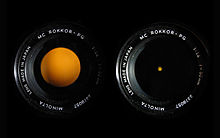Maximum and minimum apertures
The specifications for a given lens typically include the minimum and maximum apertures, such as for example f/22 - f/1.4. In this case f/22 is the smallest, or minimum aperture opening, and f/1.4 is the widest, or maximum aperture. The maximum aperture tends to be of most interest, and is always included when describing a lens. This value is also known as the lens speed, because it directly affects the exposure time. The aperture is proportional to the square root of accepted light, and thus inversely proportional to the square root of required exposure time, such that an aperture of f/2 allows for exposure times one quarter that of f/4.
Aperture values wider than f/2.8 are typically known as "fast" lenses, though this has changed historically (in the past, wider than f/6 was considered fast, for example by the 1911 Encyclopaedia Britannica). The fastest lenses in general production are f/1.2 or f/1.4, with more at f/1.8 and f/2.0, and many at f/2.8 or slower; f/1.0 is unusual, though sees some use.
In exceptional circumstances lenses can have f-numbers below f/1.0; see lens speed: fast lenses for a detailed list. For instance, in photography, both the current Leica Noctilux-M 50mm ASPH and a 1960's-era Canon 50mm rangefinder lens have a maximum aperture of f/0.95. Such lenses tend to be optically exotic and very expensive; at launch, in September 2008, the Leica Noctilux retailed for $11,000.[5] Professional lenses for some movie cameras have f-numbers as low as f/0.75. Stanley Kubrick's film Barry Lyndon has scenes shot with the largest relative aperture in film history: f/0.7. Beyond the expense, these lenses have limited application due to the correspondingly shallower depth of field – the scene must either be shallow, shot from a distance, or will be significantly defocused, though this may be a desired effect.
Zoom lenses typically have a maximum aperture (minimum f-number) of f/2.8 to f/6.3 through their range. High-end lenses will have a constant aperture, such as f/2.8 or f/4, which means that the relative aperture will stay the same throughout the zoom range. A more typical consumer zoom will have a variable relative aperture, since it is harder and more expensive to keep the effective aperture proportional to focal length at long focal lengths; f/3.5 to f/5.6 is an example of a common variable aperture range in a consumer zoom lens.
By contrast, the minimum aperture does not depend on the focal length – it is limited by how narrowly the aperture closes, not the lens design – and is instead generally chosen based on practicality: very small apertures have lower sharpness due to diffraction, while the added depth of field is not generally useful, and thus there is generally little benefit in using such apertures. Accordingly, DSLR lens typically have minimum aperture of f/16, f/22, or f/32, while large format may go down to f/64, as reflected in the name of Group f/64. Depth of field is a significant concern in macro photography, however, and there one sees smaller apertures. For example, the Canon MP-E 65mm can have effective aperture (due to magnification) as small as f/96.



No comments:
Post a Comment